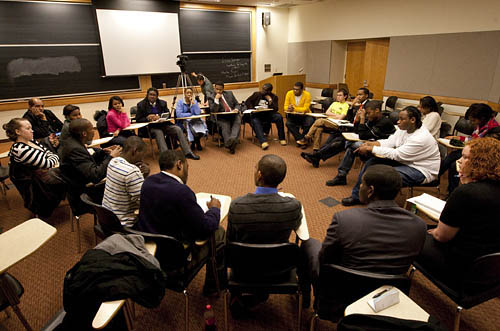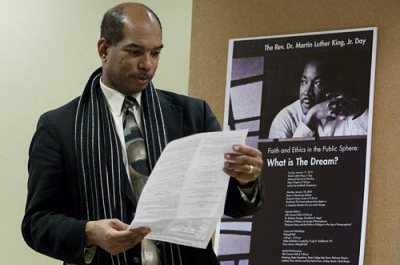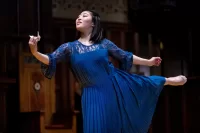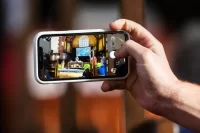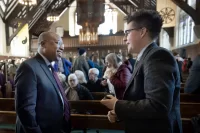
Impressions from Martin Luther King Jr. Day 2010
Editorial assistants from the Communications and Media Relations office at Bates covered a range of King Day events. Here are their reports. — Editor
Debate: ‘This house believes that religion is a necessary element of a just social change’
Students, faculty and community members braved the snow and packed into the Benjamin Mays Center as the debate teams of Bates and Morehouse colleges gathered for their annual Martin Luther King Day contest. The resolution was “This house believes that religion is a necessary element of a just social change.” Moderated by Mircea Lupu ’11, Brooks Quimby debaters Ariela Silberstein ’10 and Colin Etnire ’12 represented the government, with Morehouse junior Matt Johnson and sophomore A.J. Smith in opposition. In a vigorous and skillful tug-of-war over what is necessary to achieve justice, arguments explored such concepts as religion’s capacity for shifting the moral focus of its practitioners and the idea that good will is not inherent in religious people. Midway through, the audience was invited to participate in floor speeches, and members of the Bates community contributed beliefs, historical references and experiences regarding the resolution. But unlike most debates, this one had no winner: As director of debate Jan Hovden said, what’s far more important than deciding who is right and who is wrong is the opportunity to “meet at the intersection of social change and religion” and have a provocative conversation. (Naima Murphy ’10)
Workshop: ‘ “Aliens, Townies, and Terrorists”: The Politics of Representation on Halloween’
Students piled into a Pettengill classroom to gain perspective and share opinions about costumes, clothing, the meanings of dressing as self or other, and the often-mindless implications and assumptions that people display about race and identity through their apparel. Senior anthropology majors Julia Caffrey, Emily Chin, Nori Down, Katie Mack, Caitlin McKitrick, Lily Sullivan and Natalie Woolworth led this discussion focused on the complicated issues of context, intention vs. reception, and costume vs. clothing. The discussion began with a critical investigation of potentially offensive Halloween costumes (“Native American princess,” “terrorist” and “townie,” to name a few). The panelists invited the viewpoints of the attendees, withholding their own perspectives until the latter group had spoken. Down posed the thought-provoking question: “Whose right is it to decide if [a costume] is offensive or if it’s just a joke?” Another topic was the dilemma of deciding when the clothing of another culture is flattering and at what point it becomes offensive. Is it OK to transplant practices from one culture to another for the sake of art and entertainment? Although there were clearly many areas of disagreement, the panelists promoted politeness as a way to unite people in these difficult situations. Woolworth suggested that the most effective ways to address such issues and prevent offensive situations are to “talk about it before it happens” and try to better align our intentions and possible receptions before choosing an outfit. (Marielle Vigneau-Britt ’10)
Film: ‘Brother to Brother’
Writer, producer and director Rodney Evans was on hand to present his award-winning 2004 film “Brother to Brother.” The film follows the emotional journey of Perry, a young, gay black artist living in modern New York who learns about the hidden culture of gay and lesbian writers and poets during the Harlem Renaissance. Perry is based upon Evans’ own experiences, but also has a historical perspective. Perry befriends an elderly homeless man who turns out to be an important figure of the Harlem Renaissance. This man, Bruce Nugent, teaches Perry about the difficulties confronting gays and lesbians during this time period — which haven’t changed much. Authors Langston Hughes and Zora Neale Hurston are also depicted in the film’s flashbacks of Nugent’s young adulthood. The film, which took six years to make and combines a mix of filmic genres including historical footage, began with a short diary segment about Evans’ experiences as a black gay man in New York. Presented by professor Charles Nero, chair of the Martin Luther King Jr. Day Committee at Bates, Evans offered a short introduction and answered a few questions from an audience that filled Pettengill G21 to overflowing. The most interesting query, in the context of a day that examines inequality from all angles, involved the scarcity of films about lesbians relative to those about gay men. Evans replied that all women filmmakers find it harder than men to raise money, and for lesbians it’s even harder. (Brittney French ’11)
Workshop: ‘Something Sanctified: The Relationship of Black Sacred Music to Jazz’
The audience at Tom Hayward’s workshop could not sit still. The group in the Pettengill classroom, even the lecturer himself, couldn’t help but nod heads and tap feet to the music of Duke Ellington, Louis Armstrong, Charles Mingus and other jazz greats. A lecturer in classical and medieval studies and a reference librarian at Bates, Hayward is also a passionate jazz aficionado whose MLK Day presentation showed connections between African American spirituals and the evolution of jazz. And Hayward looked directly to Martin Luther King Jr. with the Ellington tune “King Fit the Battle of Alabam.” Ellington adapted it from the gospel song “Joshua Fit the Battle [of Jericho],” changing the lyrics to honor King and the civil rights marchers of Birmingham, Ala. — a moving commemoration of this great leader. (Gabrielle Otto ’11)
Film: ‘Neighbor by Neighbor’
The day’s events included a look at the power of community organizing as the documentary “Neighbor by Neighbor: Mobilizing an Invisible Community in Lewiston” by Craig Saddlemire ’05 was shown in the Olin Arts Center. The film emphasizes the need for just representation and community engagement in the civic arena, linking the social mobilization tactics of King’s era with contemporary concerns. The 90-minute film chronicles changes in a downtown neighborhood from 2003 to 2008 as residents, calling themselves the Visible Community, organized to resist a proposed urban renewal plan unveiled in June 2004. The city government proposed a new access road that would demolish a community garden and affordable housing for 850 residents. The film reminds us that the kinds of injustice King fought against are still a factor. Saddlemire hopes his film’s example of nonviolent activism at the local level will inspire awareness and political action nationally. “Community organization is the basis of everything,” he said in an interview.
“The more opportunities you give people to meet each other at eye level, share stories of struggle and develop empathy for one another, despite social and economic differences, the more people are willing to work for one another’s needs and interests.” A discussion with Saddlemire and members of the Visible Community followed the screening, with attendees inquiring about the organization’s growing interaction with local government, including the election of one member to the city council. As the session closed, the conversation with local residents flowed out into the Olin Arts Center corridors, carrying beyond the classroom the collaboration among citizens from varying class dynamics and levels of privilege. (Kelly Cox ’11)
Workshop: ‘Flannery O’Connor and the Matter of Race: Continuing the Conversation’
The age-old conflict between loving an artist’s work and deploring the artist’s attitude drove this workshop exploring one example of racial issues in literature. Though deploring O’Connor’s racism, Multifaith Chaplain William Blaine-Wallace and Eden Osucha, assistant professor of English, explained that they have nevertheless been deeply affected by the author’s writing. Reflecting the day’s unifying theme of faith and ethics in the public sphere, the session looked at the author’s strict Catholicism, her bigotry toward African Americans, and how these attitudes influenced her writing. Workshop attendees related their own O’Connor experiences, voicing varied interpretations of the author’s caricatures of African Americans. But Osucha noted that if reading the author’s often grotesque and inflammatory work is hard, its examination is important to continued progress in the dialogue on race. (Caty Green ’10)
Student arts and performance: ‘The Evening Program’
Every seat in the Olin Arts Center Concert Hall was taken as student performances brought Martin Luther King Jr. Day to a close. Highlights of the nighttime talent showcase included the Bates Gospelaires, a new gospel choir whose performance reflected the day’s theme, “Faith and Ethics in the Public Sphere”; and the Bates Step Team, representing the African American dance genre that uses the whole body as percussion by stomping and clapping. The team asked what King’s dream meant to the audience, who responded with “power,” “hope,” “faith,” “integrity,” and finally a standing ovation. Other offerings included a scene from Martin Duberman’s play “In White America”; a variety of dance performances; a hip-hop/R&B performance on devastation caused by HIV in the black community; and the student band “The Hybrid Suns,” who played two original songs relevant to King’s legacy. The Bates Students for Relief in Haiti also took up a collection. As baskets were passed and students reached for their wallets, Anthony Miller, a Morehouse College senior, gave a convincing reading of King’s iconic “I Have a Dream” speech, bringing the crowd to its feet in thunderous applause. Outside the hall in the Olin lobby, junior Clyde Bango of Harare, Zimbabwe, showed portraits and sculpture that he created of King. (Becca Chacko ’10)
